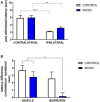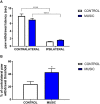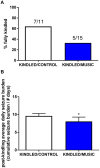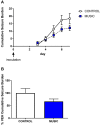Music-Enhanced Analgesia and Antiseizure Activities in Animal Models of Pain and Epilepsy: Toward Preclinical Studies Supporting Development of Digital Therapeutics and Their Combinations With Pharmaceutical Drugs
- PMID: 30972009
- PMCID: PMC6446215
- DOI: 10.3389/fneur.2019.00277
Music-Enhanced Analgesia and Antiseizure Activities in Animal Models of Pain and Epilepsy: Toward Preclinical Studies Supporting Development of Digital Therapeutics and Their Combinations With Pharmaceutical Drugs
Abstract
Digital therapeutics (software as a medical device) and mobile health (mHealth) technologies offer a means to deliver behavioral, psychosocial, disease self-management and music-based interventions to improve therapy outcomes for chronic diseases, including pain and epilepsy. To explore new translational opportunities in developing digital therapeutics for neurological disorders, and their integration with pharmacotherapies, we examined analgesic and antiseizure effects of specific musical compositions in mouse models of pain and epilepsy. The music playlist was created based on the modular progression of Mozart compositions for which reduction of seizures and epileptiform discharges were previously reported in people with epilepsy. Our results indicated that music-treated mice exhibited significant analgesia and reduction of paw edema in the carrageenan model of inflammatory pain. Among analgesic drugs tested (ibuprofen, cannabidiol (CBD), levetiracetam, and the galanin analog NAX 5055), music intervention significantly decreased paw withdrawal latency difference in ibuprofen-treated mice and reduced paw edema in combination with CBD or NAX 5055. To the best of our knowledge, this is the first animal study on music-enhanced antinociceptive activity of analgesic drugs. In the plantar incision model of surgical pain, music-pretreated mice had significant reduction of mechanical allodynia. In the corneal kindling model of epilepsy, the cumulative seizure burden following kindling acquisition was lower in animals exposed to music. The music-treated group also exhibited significantly improved survival, warranting further research on music interventions for preventing Sudden Unexpected Death in Epilepsy (SUDEP). We propose a working model of how musical elements such as rhythm, sequences, phrases and punctuation found in K.448 and K.545 may exert responses via parasympathetic nervous system and the hypothalamic-pituitary-adrenal (HPA) axis. Based on our findings, we discuss: (1) how enriched environment (EE) can serve as a preclinical surrogate for testing combinations of non-pharmacological modalities and drugs for the treatment of pain and other chronic diseases, and (2) a new paradigm for preclinical and clinical development of therapies leading to drug-device combination products for neurological disorders, depression and cancer. In summary, our present results encourage translational research on integrating non-pharmacological and pharmacological interventions for pain and epilepsy using digital therapeutics.
Keywords: arthritis; cancer pain; epileptic seizures; inflammation; mobile medical apps; neuropathic pain; opioids; refractory epilepsy.
Figures









Similar articles
-
From Precision Metapharmacology to Patient Empowerment: Delivery of Self-Care Practices for Epilepsy, Pain, Depression and Cancer Using Digital Health Technologies.Front Pharmacol. 2021 Apr 23;12:612602. doi: 10.3389/fphar.2021.612602. eCollection 2021. Front Pharmacol. 2021. PMID: 33972825 Free PMC article.
-
Mobile Software as a Medical Device (SaMD) for the Treatment of Epilepsy: Development of Digital Therapeutics Comprising Behavioral and Music-Based Interventions for Neurological Disorders.Front Hum Neurosci. 2018 May 1;12:171. doi: 10.3389/fnhum.2018.00171. eCollection 2018. Front Hum Neurosci. 2018. PMID: 29780310 Free PMC article.
-
Digital Therapeutics for Improving Effectiveness of Pharmaceutical Drugs and Biological Products: Preclinical and Clinical Studies Supporting Development of Drug + Digital Combination Therapies for Chronic Diseases.J Clin Med. 2024 Jan 11;13(2):403. doi: 10.3390/jcm13020403. J Clin Med. 2024. PMID: 38256537 Free PMC article. Review.
-
Incorporating Natural Products, Pharmaceutical Drugs, Self-Care and Digital/Mobile Health Technologies into Molecular-Behavioral Combination Therapies for Chronic Diseases.Curr Clin Pharmacol. 2016;11(2):128-45. doi: 10.2174/1574884711666160603012237. Curr Clin Pharmacol. 2016. PMID: 27262323 Free PMC article. Review.
-
Parasympathetic activation is involved in reducing epileptiform discharges when listening to Mozart music.Clin Neurophysiol. 2013 Aug;124(8):1528-35. doi: 10.1016/j.clinph.2013.02.021. Epub 2013 Mar 27. Clin Neurophysiol. 2013. PMID: 23540417 Clinical Trial.
Cited by
-
Musicotherapy mobile applications: what level of evidence and potential role in psychiatric care? A systematic review.Front Psychiatry. 2024 Jun 7;15:1366575. doi: 10.3389/fpsyt.2024.1366575. eCollection 2024. Front Psychiatry. 2024. PMID: 38911704 Free PMC article.
-
Non-pharmacological Interventions for Intractable Epilepsy.Saudi Pharm J. 2020 Aug;28(8):951-962. doi: 10.1016/j.jsps.2020.06.016. Epub 2020 Jun 29. Saudi Pharm J. 2020. PMID: 32792840 Free PMC article. Review.
-
Sudden Unexpected Death in Epilepsy: Central Respiratory Chemoreception.Int J Mol Sci. 2025 Feb 13;26(4):1598. doi: 10.3390/ijms26041598. Int J Mol Sci. 2025. PMID: 40004062 Free PMC article. Review.
-
Effects of Hyssopus Officinalis Hydroalcoholic Extract on Pentylenetetrazol-Induced Convulsive Seizures in Rat.Neurochem Res. 2022 Dec;47(12):3792-3804. doi: 10.1007/s11064-022-03759-x. Epub 2022 Oct 26. Neurochem Res. 2022. PMID: 36287300
-
From Precision Metapharmacology to Patient Empowerment: Delivery of Self-Care Practices for Epilepsy, Pain, Depression and Cancer Using Digital Health Technologies.Front Pharmacol. 2021 Apr 23;12:612602. doi: 10.3389/fphar.2021.612602. eCollection 2021. Front Pharmacol. 2021. PMID: 33972825 Free PMC article.
References
-
- Centers for Disease Control and Prevention Centers for Disease Control and Prevention. Available online at: https://www.cdc.gov/
-
- Bulaj G, Ahern MM, Kuhn A, Judkins ZS, Bowen RC, Chen Y. Incorporating natural products, pharmaceutical drugs, self-care and digital/mobile health technologies into molecular-behavioral combination therapies for chronic diseases. Curr Clin Pharmacol. (2016) 11:128–45. 10.2174/1574884711666160603012237 - DOI - PMC - PubMed
LinkOut - more resources
Full Text Sources
Medical

